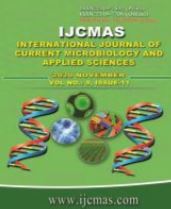


 National Academy of Agricultural Sciences (NAAS)
National Academy of Agricultural Sciences (NAAS)

|
PRINT ISSN : 2319-7692
Online ISSN : 2319-7706 Issues : 12 per year Publisher : Excellent Publishers Email : editorijcmas@gmail.com / submit@ijcmas.com Editor-in-chief: Dr.M.Prakash Index Copernicus ICV 2018: 95.39 NAAS RATING 2020: 5.38 |
The present investigation was undertaken with 30 rice genotypes to estimate the nature and magnitude of genetic divergence for yield and nutritional traits. The 30 genotypes were categorized into six clusters based on D² values using agglomerative hierarchical clustering complete linkage based on Mahalanobis distance. Cluster I was largest comprising of nine genotypes followed by cluster III and IV comprising of seven and six genotypes respectively. Maximum intra cluster distance was observed in cluster IV (95.017) followed by cluster VI (79.535) indicating greater genetic diversity among the genotypes present in these clusters. The highest inter cluster distance (213.16) was observed between cluster IV and V, followed by cluster I and V (173.93). Genotypes present in the cluster IV recorded highest mean values for the number of productive tillers plant-1, panicle length, 100 grain weight, total antioxidant activity, total soluble phenol content and amylose (intermediate). Hence, the genotypes from these clusters may be considered as parents in hybridization programme for obtaining superior transgressive segregants with respect to yield and nutritional content. Principal component analysis was utilized to evaluate the variation and to estimate the relative contribution of various traits towards total variability. The results revealed five principal components with Eigen value more than one contributed 75.56% towards the total variability. The traits contributing maximum towards the existing variability were plant height, panicle length, spikelet fertility, yield plot-1, 100 grain weight, iron content, antioxidant activity and phenol content.
 |
 |
 |
 |
 |